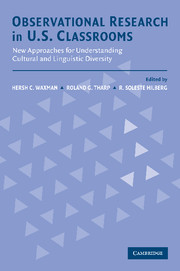 Observational Research in U.S. Classrooms
Observational Research in U.S. Classrooms Book contents
- Frontmatter
- Contents
- Tables, Figures, and Appendixes
- Contributors
- 1 Introduction: Purposes and Perspectives on Classroom Observation Research
- 2 Using Multiple Perspectives in Observations of Diverse Classrooms: The Sheltered Instruction Observation Protocol (SIPO)
- 3 The Standards Performance Continuum: A Performance-Based Measure of the Standards for Effective Pedagogy
- 4 The Uses of the Classroom Observation Schedule to Improve Classroom Instruction
- 5 Development and Use of a Classroom Observation Instrument to Investigate Teaching for Meaning in Diverse Classrooms
- 6 Patterns of Language Arts Instructional Activity and Excellence in First– and Fourth–Grade Culturally and Linguistically Diverse Classrooms
- 7 Using Classroom Observation as a Research and Formative Evaluation Tool in Educational Reform: The School Observation Measure
- 8 Observing School Restructuring in Multilingual, Multicultural Classrooms: Balancing Ethnographic and Evaluative Approaches
- 9 Sociocultural Activity Settings in the Classroom: A Study of a Classroom Observation System
- 10 The Influence of School Reform on Classroom Instruction in Diverse Schools: Findings from an Observational Study of Success for All
- 11 Future Directions for Classroom Observation Research
- Index
- References
1 - Introduction: Purposes and Perspectives on Classroom Observation Research
Published online by Cambridge University Press: 23 November 2009
- Frontmatter
- Contents
- Tables, Figures, and Appendixes
- Contributors
- 1 Introduction: Purposes and Perspectives on Classroom Observation Research
- 2 Using Multiple Perspectives in Observations of Diverse Classrooms: The Sheltered Instruction Observation Protocol (SIPO)
- 3 The Standards Performance Continuum: A Performance-Based Measure of the Standards for Effective Pedagogy
- 4 The Uses of the Classroom Observation Schedule to Improve Classroom Instruction
- 5 Development and Use of a Classroom Observation Instrument to Investigate Teaching for Meaning in Diverse Classrooms
- 6 Patterns of Language Arts Instructional Activity and Excellence in First– and Fourth–Grade Culturally and Linguistically Diverse Classrooms
- 7 Using Classroom Observation as a Research and Formative Evaluation Tool in Educational Reform: The School Observation Measure
- 8 Observing School Restructuring in Multilingual, Multicultural Classrooms: Balancing Ethnographic and Evaluative Approaches
- 9 Sociocultural Activity Settings in the Classroom: A Study of a Classroom Observation System
- 10 The Influence of School Reform on Classroom Instruction in Diverse Schools: Findings from an Observational Study of Success for All
- 11 Future Directions for Classroom Observation Research
- Index
- References
Summary
The purpose of this book is to provide researchers, scholars, and educators with examples of recently developed classroom observation instruments based on current research on effective teaching practices, many developed explicitly for use in today's culturally and linguistically diverse classrooms. The chapters describe several new instruments and include examples of how they have been used to examine effective instruction, schools, and school-based reform models in classrooms and schools with diverse students. Although most observational research in culturally and linguistically diverse settings has been qualitative, systematic classroom observation research has been widely used during the past three decades (Waxman, 1995; Waxman & Huang, 1999). And, although findings from that research have led to a substantive knowledge base on effective teaching practices (Brophy & Good, 1986; Waxman & Walberg, 1982), many critics have argued that systematic observation lacks a theoretical/conceptual framework and merely focuses on discrete categories or small segments of observable teacher behaviors that can be easily measured with observation instruments (Ornstein, 1991). Indeed, most of the early observation instruments focused on direct instruction and easily quantifiable behaviors associated with basic skills instruction, rendering them inappropriate, or when used alone inadequate, for examining today's diverse classrooms. Today, researchers and educators need instruments based on the most recent theoretical/conceptual work and empirical research on effective pedagogy (Tharp, Estrada, Dalton, & Yamauchi, 2000; Waxman & Walberg, 1999). This book presents a rich variety of such instruments.
- Type
- Chapter
- Information
- Observational Research in U.S. ClassroomsNew Approaches for Understanding Cultural and Linguistic Diversity, pp. 1 - 20Publisher: Cambridge University PressPrint publication year: 2004
References
- 8
- Cited by
